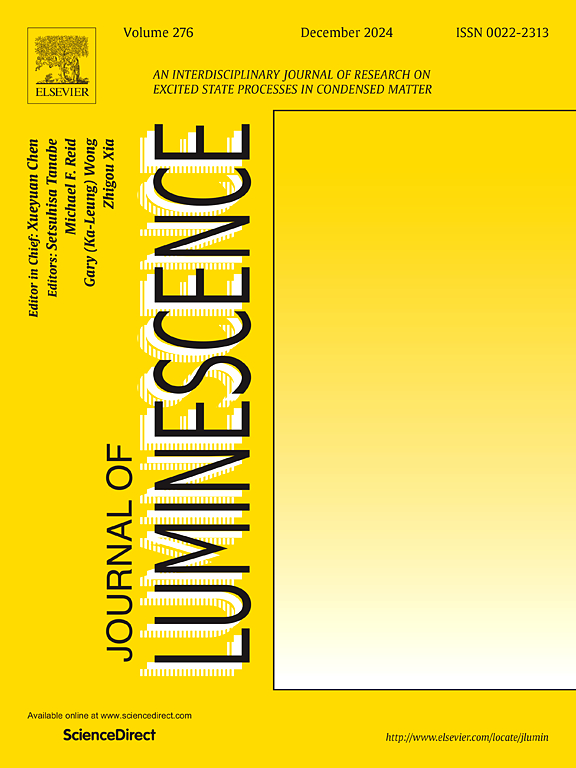Photoluminescence characteristics and Judd–Ofelt analysis of YBa3(BO3)3:Tb3+ phosphors co-doped with Li+, Na+, and K+
IF 3.3
3区 物理与天体物理
Q2 OPTICS
引用次数: 0
Abstract
This study presents a systematic investigation of the photoluminescent properties of Tb3+-doped YBa3(BO3)3 (YBBO) phosphors, synthesized via a microwave-assisted sol-gel combustion (MA-SG) method and co-doped with monovalent alkali ions (Li+, Na+, K+). Structural, vibrational, and morphological analyses were performed using XRD with Rietveld refinement, Raman and FTIR spectroscopy, and SEM–EDS. These analyses confirmed the successful incorporation of dopants without compromising the borate lattice. Photoluminescence (PL) measurements under near-UV excitation (377 nm) showed intense green emission attributed to the 5D4 → 7F5 transition of Tb3+, with Li+ co-doping producing the greatest enhancement (∼2.7 × ) in emission intensity. Lifetime measurements revealed longer decay times with co-doping, suggesting reduced non-radiative relaxation processes. Judd–Ofelt (J–O) analysis confirmed strong radiative transitions and high internal quantum efficiency (η ≈ 48.4 %). The internal quantum efficiency (IQE) of 48.4 % was estimated using Judd–Ofelt theory, which is based on radiative transition probabilities derived from emission spectra. This method, while theoretical, is widely accepted for powdered phosphors and provides insight into the intrinsic radiative efficiency of the activator ions. Although absolute quantum yield (QY) measurements are typically obtained using integrating sphere systems to account for all optical losses, in this study, such measurements were not performed. Nonetheless, the strong agreement between radiative parameters and observed photoluminescence behavior supports the reliability of the calculated efficiency. In this study, J–O parameters were derived from the integrated emission spectra of Tb3+ transitions, following an emission-based approach that has been increasingly employed for powdered phosphors due to its experimental feasibility. Colorimetric analysis using CIE chromaticity diagrams validated the tunable green emission behaviour of the phosphors. Minor deviations from ideal green were linked to background blue emission from the host matrix, a feature that may offer spectral advantages in multifunctional optical applications. Furthermore, the phosphor exhibited a rare negative thermal quenching (NTQ) behavior, maintaining or enhancing emission intensity up to 550 K, which is superior to many commercial green phosphors.These results highlight the crucial role of alkali ion co-doping in tuning the local crystal field, enhancing emission efficiency, and paving the way for the development of efficient green-emitting phosphors for solid-state lighting applications.
Li+、Na+、K+共掺杂YBa3(BO3)3:Tb3+荧光粉的光致发光特性及Judd-Ofelt分析
本研究系统地研究了Tb3+掺杂YBa3(BO3)3 (YBBO)荧光粉的光致发光性能,该荧光粉是通过微波辅助溶胶-凝胶燃烧(MA-SG)方法合成的,并与一价碱离子(Li+, Na+, K+)共掺杂。结构、振动和形态分析采用XRD、Rietveld细化、拉曼光谱和FTIR光谱以及SEM-EDS进行。这些分析证实了在不影响硼酸盐晶格的情况下,掺杂剂的成功掺入。近紫外激发(377 nm)下的光致发光(PL)测量显示,Tb3+的5D4→7F5跃迁产生了强烈的绿色发射,其中Li+共掺杂产生了最大的发射强度增强(约2.7倍)。寿命测量显示,共掺杂的衰减时间更长,表明非辐射弛豫过程减少。Judd-Ofelt (J-O)分析证实了强辐射跃迁和高内量子效率(η≈48.4%)。利用Judd-Ofelt理论估计了内量子效率(IQE)为48.4%,该理论基于发射光谱的辐射跃迁概率。这种方法虽然是理论上的,但被广泛接受用于粉末荧光粉,并提供了对激活剂离子的固有辐射效率的见解。虽然绝对量子产率(QY)测量通常使用积分球系统来获得,以解释所有光学损耗,但在本研究中,没有进行这样的测量。尽管如此,辐射参数与观测到的光致发光行为之间的强烈一致性支持了计算效率的可靠性。在本研究中,J-O参数是从Tb3+跃迁的集成发射光谱中得出的,采用了基于发射的方法,由于其实验可行性,该方法已越来越多地用于粉末荧光粉。使用CIE色度图的比色分析验证了荧光粉的可调绿色发射行为。与理想绿色的微小偏差与宿主矩阵的背景蓝色发射有关,这一特征可能在多功能光学应用中提供光谱优势。此外,该荧光粉表现出罕见的负热猝灭(NTQ)行为,在高达550 K的温度下保持或增强发射强度,优于许多商用绿色荧光粉。这些结果突出了碱离子共掺杂在调谐局部晶体场,提高发射效率方面的关键作用,并为开发用于固态照明的高效绿色发光荧光粉铺平了道路。
本文章由计算机程序翻译,如有差异,请以英文原文为准。
求助全文
约1分钟内获得全文
求助全文
来源期刊

Journal of Luminescence
物理-光学
CiteScore
6.70
自引率
13.90%
发文量
850
审稿时长
3.8 months
期刊介绍:
The purpose of the Journal of Luminescence is to provide a means of communication between scientists in different disciplines who share a common interest in the electronic excited states of molecular, ionic and covalent systems, whether crystalline, amorphous, or liquid.
We invite original papers and reviews on such subjects as: exciton and polariton dynamics, dynamics of localized excited states, energy and charge transport in ordered and disordered systems, radiative and non-radiative recombination, relaxation processes, vibronic interactions in electronic excited states, photochemistry in condensed systems, excited state resonance, double resonance, spin dynamics, selective excitation spectroscopy, hole burning, coherent processes in excited states, (e.g. coherent optical transients, photon echoes, transient gratings), multiphoton processes, optical bistability, photochromism, and new techniques for the study of excited states. This list is not intended to be exhaustive. Papers in the traditional areas of optical spectroscopy (absorption, MCD, luminescence, Raman scattering) are welcome. Papers on applications (phosphors, scintillators, electro- and cathodo-luminescence, radiography, bioimaging, solar energy, energy conversion, etc.) are also welcome if they present results of scientific, rather than only technological interest. However, papers containing purely theoretical results, not related to phenomena in the excited states, as well as papers using luminescence spectroscopy to perform routine analytical chemistry or biochemistry procedures, are outside the scope of the journal. Some exceptions will be possible at the discretion of the editors.
 求助内容:
求助内容: 应助结果提醒方式:
应助结果提醒方式:


